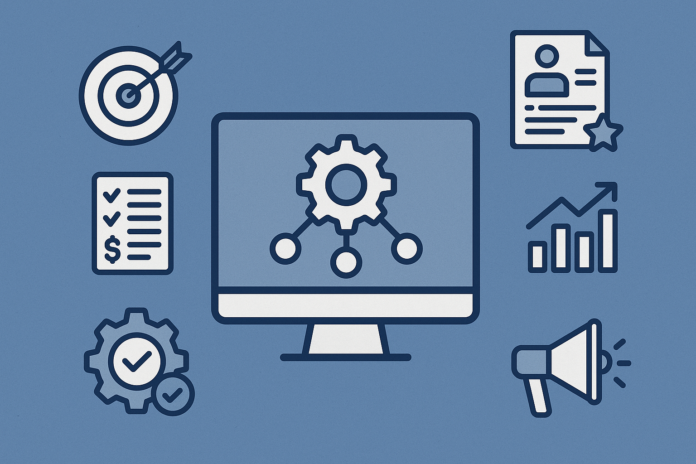Marketing automation has shifted from a tactical tool to a strategic necessity in B2B marketing. No longer just about email sequences or lead scoring, today’s platforms offer a breadth of capabilities that are reshaping how B2B marketers engage prospects, qualify leads, and measure performance.
Here are six of the most significant ways automation is changing the B2B marketing landscape.
Turning lead nurturing into a science
In traditional B2B models, lead nurturing was often manual, slow, and inconsistent. Marketing automation platforms have revolutionised this by enabling highly targeted, behaviour-based nurture programmes. Now, leads receive tailored content based on what they download, where they work, how they interact with your website, and even how long they linger on specific pages.
Tools like HubSpot, Pardot, and Marketo let marketers build intelligent workflows that adapt to buyer behaviour in real time. For example, if a user downloads a whitepaper on compliance but ignores follow-up content, the system can automatically shift the messaging to a more top-of-funnel angle. This kind of contextual agility isn’t just convenient – it significantly increases the likelihood of conversion.
Aligning sales and marketing with smarter lead scoring
Marketing and sales alignment is a constant challenge in B2B. Automation tools are helping bridge the gap by creating a shared language through lead scoring and qualification models.
Rather than relying on anecdotal feedback or gut instinct, automation platforms use real-time data to assess each lead’s readiness. Engagement metrics, firmographic data, and behavioural signals can be automatically weighted to produce a score that both teams understand and trust.
This is particularly powerful for account-based marketing (ABM), where identifying high-intent signals early can make the difference between a closed deal and a missed opportunity. When sales and marketing agree on what a “sales-ready” lead looks like, follow-ups become more timely, relevant, and successful.
Reducing manual tasks and freeing up strategic thinking
Automation doesn’t just make campaigns more effective – it also makes marketing teams more efficient. Repetitive manual tasks like contact segmentation, email list updates, social post scheduling, and form responses can now be handled automatically.
This frees up B2B marketers to focus on strategic tasks: campaign planning, content creation, testing hypotheses, and refining messaging. Rather than spending hours pulling reports or uploading contacts, teams can spend that time understanding why a campaign succeeded (or failed) and how to improve it.
Crucially, this also reduces the likelihood of human error in large-scale campaigns – especially when sending to global audiences or integrating multiple data sources.
Powering true personalisation at scale
Personalisation used to mean inserting someone’s first name into an email. Now, thanks to automation, B2B marketers can deliver dynamic content tailored to an individual’s role, company size, industry, behaviour, and stage in the funnel – all without manual intervention.
Modern tools allow for dynamic landing pages, emails, and even entire web experiences to adjust based on visitor data. For example, a procurement officer from a manufacturing firm in Leeds might see different messaging and case studies than a CTO from a SaaS startup in London.
This kind of high-quality, scalable personalisation is vital in B2B, where purchase decisions are complex and involve multiple stakeholders. It ensures each contact receives the right message at the right time – increasing trust, engagement, and ultimately, conversion.
Improving measurement and campaign optimisation
Gone are the days when marketers had to wait weeks to measure a campaign’s effectiveness. Automation technology gives teams access to real-time dashboards and performance metrics across channels.
Platforms like ActiveCampaign, Eloqua, and Customer.io offer integrated analytics that show exactly how contacts move through the funnel. Which email drove the most demo requests? Which whitepaper led to the most SQLs? Which LinkedIn campaign contributed most to pipeline value?
Marketers can now test, optimise, and iterate campaigns far more rapidly – refining subject lines, CTAs, segmentation rules, and content assets on the fly. The result is not just better performance, but a culture of continuous improvement grounded in real data.
Enabling more effective multichannel engagement
B2B buyers are no longer confined to one or two touchpoints. A typical decision-making journey spans email, search, social, webinars, events, and direct website interaction. Marketing automation platforms now make it easier to coordinate multichannel engagement without losing coherence.
For example, a contact who registers for a webinar might trigger an automated journey involving reminder emails, LinkedIn ads, a thank-you sequence, and then a follow-up from sales. All of this can be orchestrated within one system, creating a consistent and seamless experience.
Automation also ensures that each channel plays to its strength. Emails can carry gated content, social platforms can be used for awareness and retargeting, and CRM integrations can ensure timely outreach from sales. With all these systems talking to one another, the brand experience becomes cohesive and intelligent.
Final thoughts
Marketing automation is not just a tool – it’s a transformation. It allows B2B marketers to scale their efforts without sacrificing personalisation, to act on data instead of assumptions, and to build campaigns that adapt in real time.
However, the power of automation lies not in the software itself, but in how it’s used. The best results come from teams that combine strong strategy, quality content, and human insight with the technical capabilities of modern platforms.
As automation technology continues to evolve, the most successful B2B marketers will be those who use it not just to do more, but to do better.


 Whether you want to learn how to use LinkedIn, X or Facebook for marketing, or need to brush up on business skills like leadership, presentation skills or managing meetings, you will find something to enhance your professional skills with these on-demand courses.
Whether you want to learn how to use LinkedIn, X or Facebook for marketing, or need to brush up on business skills like leadership, presentation skills or managing meetings, you will find something to enhance your professional skills with these on-demand courses.